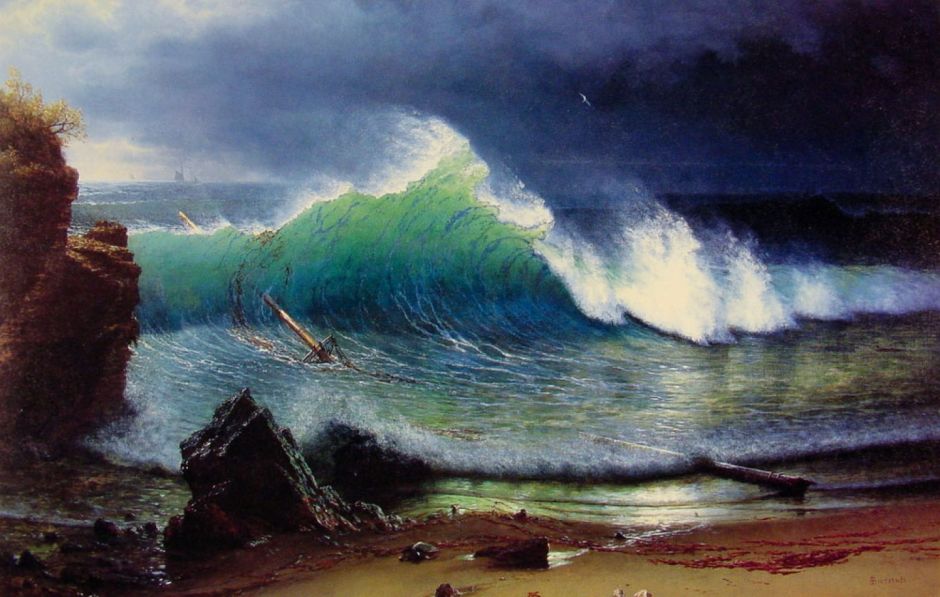In the previous of these two articles, I looked at European paintings of near-breaking ‘regular’ or “surfer’s” waves prior to 1850, and the appearance of Katsushika Hokusai’s woodblock print of The Great Wave off Kanagawa, which became so popular in Japan.
No one knows when Hokusai’s Great Wave first appeared in Europe. Although it’s sometimes claimed that this didn’t happen until the re-opening of Japan to the West with the Meiji Restoration in 1868, there are records of the first ukiyo-e prints reaching the hands of artists in France more than a decade earlier.
They appear to have first arrived as protective wrapping for porcelain, and in about 1856 the French artist Félix Bracquemond, also an accomplished print-maker, first came across Hokusai’s prints at the workshop of his printer. Japonism(e) spread rapidly through artistic circles in Paris and other European cities. Among those who collected these prints were Bracquemond, Vincent van Gogh, Claude Monet, Edgar Degas, Gustav Klimt, Édouard Manet, and Paul Gauguin.

In the late 1860s, Gustave Courbet’s coastal paintings came to concentrate more on the waves breaking on the beach, as in his Autumn Sea from 1867.

Then in 1869 Courbet painted a breaking ‘regular’ wave which must surely have at least been influenced by Hokusai’s popular print.

Appropriately, this development of the motif, in Courbet’s Waves from about 1870, is now in Tokyo, where it should perhaps be exhibited alongside Hokusai’s Great Wave.

Although I don’t have a date for this fine painting of Shipping off the Eddystone Lighthouse, and it has only been attributed to Anton Melbye’s younger brother Vilhelm, this too is likely to be post-Hokusai. At the right is a fine breaking wave.

It’s hard to judge the scale in Elihu Vedder’s Memory from 1870, but its waves appear much smaller, though beautifully regular. This remarkable painting is one of the earliest symbolist images made by an American artist, and is part a response to Tennyson’s poem Break, Break, Break (1842), in which he ponders the memory of loved ones when contemplating the sea. I feel sure that Vedder had at least glimpsed a Hokusai print too.

The great American landscape artist Albert Bierstadt only painted about thirty coastal views out of a total of around five hundred catalogued paintings, but at least three of them show breaking regular waves. In May 1872, he visited the Farallon Islands, a group of uninhabited rocks thirty miles to the west of San Francisco, responding with his dramatic Seals on the Rocks, Farallon Islands (c 1872-73).

Bierstadt’s wife was diagnosed with ‘consumption’ in 1876, and the following year the couple visited Nassau in the Bahamas, where they hoped the warmer climate would help her condition. During that visit, Bierstadt was inspired to paint The Shore of the Turquoise Sea (1878), showing a wave breaking on the coast there: surely a direct reference to Courbet and Hokusai. Bierstadt also painted a second, larger development from this work after 1878, now exhibited in the Haggin Museum in Stockton, CA, as After a Norther.

In France, the mainstream Impressionists and their successors seemed less impressed with Hokusai, preferring other Japonist themes such as tree blossom. The Great Wave found greater enthusiasm with Paul Gauguin and his circle who gathered first in Pont-Aven then Le Pouldu in Brittany. Gauguin’s gouache Seaweed Gatherers I (1888-90) shows two Breton women gathering seaweed on the beach. Behind them is a huge wave, its spume formed into a claw, which could only have come from Hokusai.

In 1889, Gauguin painted two works showing Ondine in the sea among waves. The first, known now as In the Waves, or Ondine (I), also refers to Hokusai.

Like JMW Turner before, Winslow Homer’s many paintings of the sea tend to depict waves for effect rather than their form. One of the few paintings in which he has formed a breaking wave regularly is this showing Cannon Rock, which he made in his nearby studio on the Maine coast.

In 1896, Great Waves swept across Europe on many canvases. Arnold Böcklin’s retelling of the story of Odysseus and Polyphemus shows Odysseus’ crew rowing frantically out to sea, through large waves, as Polyphemus prepares to hurl a huge rock at them from the shore.

Henry Moret, one of the Pont-Aven school, found his Waves at Pen-men, Île de Groix, on the far western tip of the island of Groix, with the mountainous sea for which this part of the Bay of Biscay is notorious.

The Nabi sculptor, and painter from Gauguin’s school, Georges Lacombe took Hokusai’s motif forward in several of his paintings. This is his treatment of Vorhor, The Green Wave in egg tempera, which shows an Atlantic swell coming into the seacliffs of Vorhor near Camaret-sur-Mer in Brittany.

Lacombe’s slightly later The Violet Wave also makes its influence abundantly clear.

In that same year, even the notorious academic artist William-Adolphe Bouguereau joined Hokusai’s crowd of admirers, in The Wave.

My last example of a post-Hokusai Great Wave is one of the late marine paintings of William Trost Richards: Off the Coast of Cornwall from 1904. In its impeccably-painted breakers are the spirits of Bierstadt, Courbet, and Hokusai.
A very Great Wave indeed.

